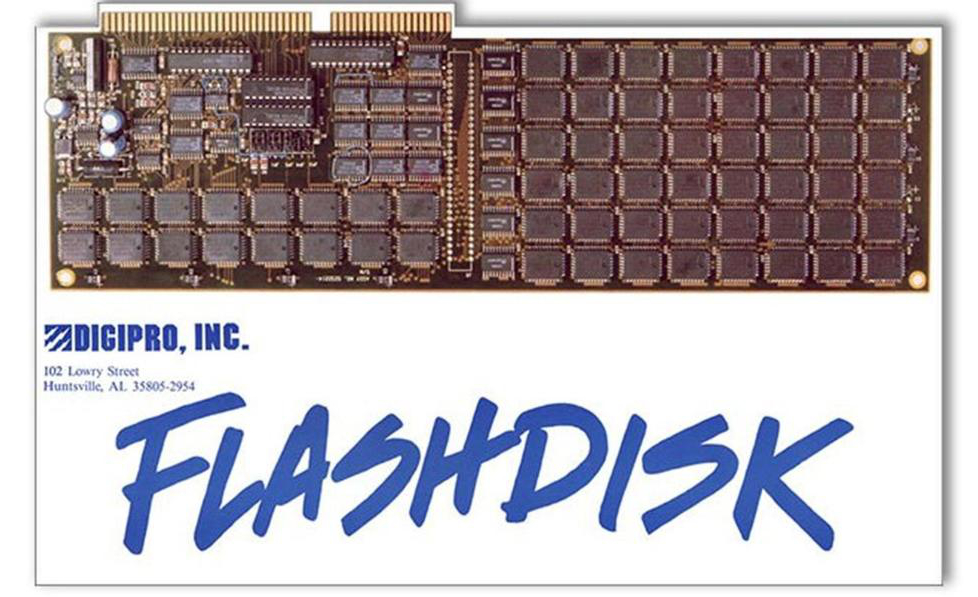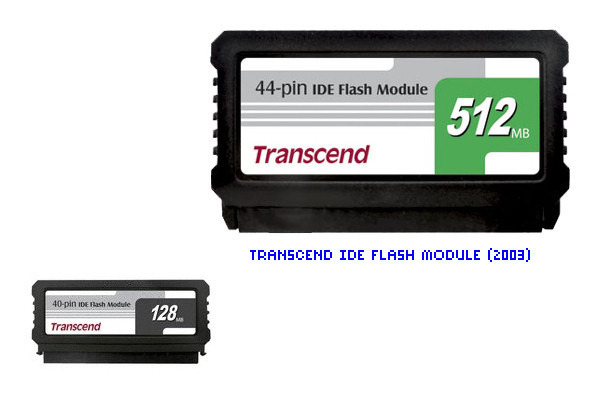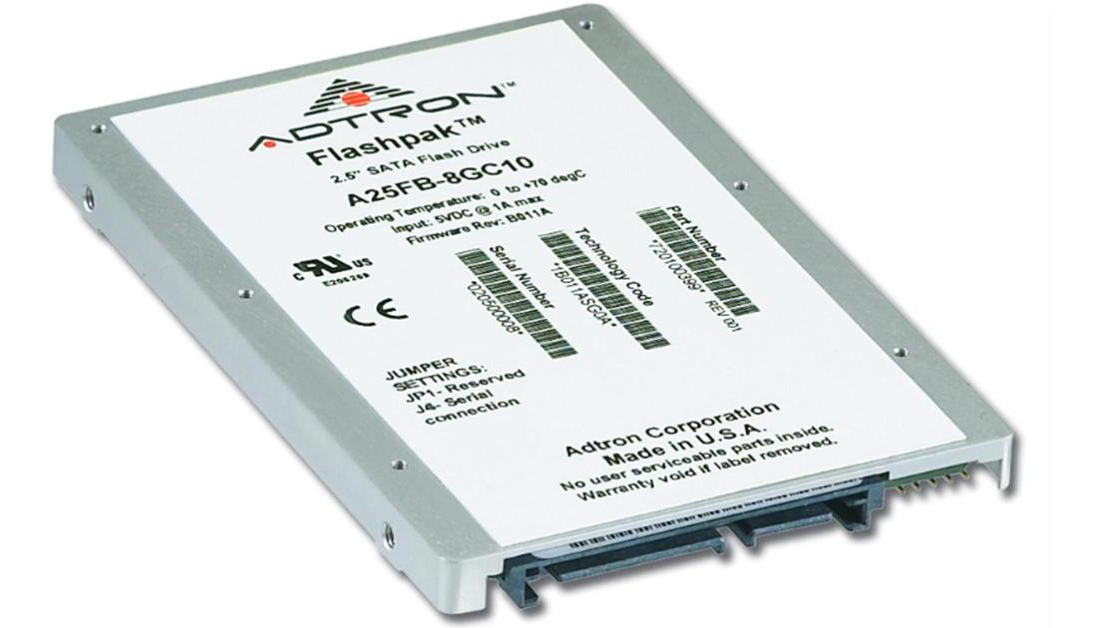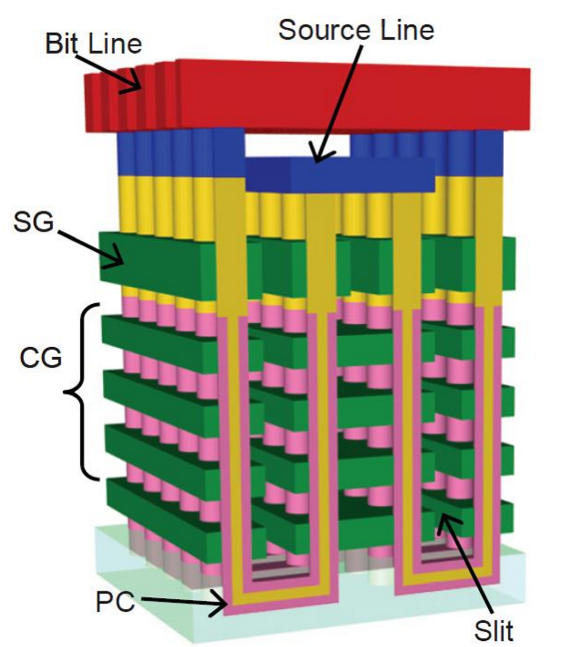The evolution of solid-state drives: from the first models of the 70s to the present day
In October 2016, we immediately presented two lines of 2.5-inch solid-state drives: WD Blue and Green SSD. In any other industry, such a move might seem risky even for a corporation such as Western Digital. Indeed, the promotion of a new product in a niche where spheres of influence have long been identified, in most cases results in large financial costs and rarely leads to positive results. However, the SSD market has its own specifics, opening up tremendous opportunities for competition, which is due to both technological features and a number of historical premises. It is about the history of the emergence of solid-state drives that we will talk today.
Strictly speaking, SSDs appeared long before the invention of flash memory. After all, what is, in fact, Solid State Drive? It is an information storage device that does not contain any mechanical components. Thus, the very first SSD in the world can be called the creation of Dataram Corporation with the proud name Bulk Core, introduced in 1976. The steel chassis with dimensions of 19 by 15.75 inches contained 8 strips of volatile RAM memory, each of which had a capacity of 256 kilobytes. The device is the size of a good UPS (and, due to the availability of backup batteries, the corresponding weight) cost at the start of 9700 US dollars. The devices are used in industry and high technology industries, but due to the high cost and unreliability (the risk of data loss was extremely great), they did not become widespread.

Dataram Bulk Core - the very first SSD
Nevertheless, only 6 years later, Axlon made an attempt to conquer the consumer segment by entering the market with an external RAM Disk drive, designed specifically for the 1982 Apple II personal computers. The novelty carried 320 kilobytes of RAM on board, had dimensions comparable to modern compact NAS and was equipped with rechargeable batteries providing 3 hours of battery life in case of power outages.

Axlon RAM Disk Advertising Brochure Encourages Boosting Your Apple II
You can guess how popular this decision has become by looking at prices: at the start of sales, the device cost $ 1,400, while Apple II itself, in a version with 4 kilobytes of RAM at that time, would have cost you $ 1,298. Even if the built-in read-only memory, this PC also had 4 kilobytes, the ability to connect a cassette recorder, and subsequently 5.25-inch drives more than compensated for this drawback. At the same time, the exorbitant price tag and the risk of losing all information made RAM Disk unattractive for the end user, especially since most users simply did not need the additional read / write speed.
All of the above devices were unprofitable due to the high cost, unreliable due to the need for a constant power source and unnecessarily cumbersome due to design features. In other words, solid state drives of the past were deprived of all the advantages of modern models, which explains their fiasco. To create a truly revolutionary solution, a fundamentally new technology was required, which appeared only in the mid-80s with the invention of flash memory.
Semiconductor storage devices existed before: the first EPROM was created by Dov Frohman back in 1971, however, such chips were not suitable for the role of even a removable drive. The thing is that the information erasing procedure was carried out by directly irradiating the transistor matrix with an ultraviolet mercury lamp, for which there was even a small quartz glass window located directly above the chip in the case. More advanced EEPROMs were already electrically erasable ROMs, however, to implement this feature, a second transistor controlling the recording and erasing modes had to be introduced into a standard cell. Because of this, the wiring area of the matrix components (and, therefore, the chip itself) significantly increased, and as a result, it was necessary to sacrifice the compactness of the devices.
Therefore, the main scientific research was conducted in the field of creating microcircuits with a denser arrangement of erase chains. And those were successful in 1984 when Fujio Masuoka, who worked at Toshiba Corporation, presented a prototype of non-volatile flash memory at the International Electron Devices Meeting, held at the Institute of Electrical and Electronics Engineers (IEEE).

Fujio Masuoka, inventor of flash memory
The name was coined by his colleague, Shoji Ariizumi, who compared the process of erasing data with a flash of lightning. Unlike EEPROM, flash memory was based on MOS transistors with an additional floating gate located between the p-layer and the control gate, which allowed the creation of truly miniature chips.
Intel's first NOR (Not-Or) technology was launched in 1988 as the first commercial flash memory model. Matrices of this type were a two-dimensional array in which each memory cell was at the intersection of a row and a column (the corresponding conductors were connected to different gates of the transistor, and the source to a common substrate). However, already in 1989, Toshiba introduced NAND flash memory. The array had a similar structure, but in each of its nodes, instead of a single cell, several series-connected cells were now located. In addition, two MOS transistors were used in each line - a control located between the discharge line and the cell column, and a ground transistor.
The higher density of the arrangement helped to increase the capacity of the chip, but the read / write algorithm became more complicated, which affected the speed of information exchange. In this regard, the new architecture was not able to completely supplant NOR, which was used in the creation of embedded ROMs, while NAND was used in the manufacture of portable drives (USB-flash drives, SD-cards). By the way, the production of the latter became possible only in 2000, when the cost of flash memory dropped sufficiently and such devices could pay off, and the IBM DiskOneKey model, the volume of which was only 8 megabytes, became the first “sign”. A little, however, let's not forget that the miniature device with the size of a keychain has successfully replaced eight 3.5-inch floppy disks.

IBM DiskOneKey flash drive
Since the release of flash chips is a technologically complex and knowledge-intensive process, there are only a few companies specializing in their production, among which SanDisk should be highlighted. She has over 200 patents in her account, licenses for the use of which were subsequently acquired by such well-known players as Intel, Hitachi, Samsung and Sony. Among the main achievements of the enterprise it is worth mentioning the introduction of the CompactFlash standard (1994), the development of the MultiMedia Card (1997) and the Secure Digital Memory Card (SD) format created together with Toshiba in 2000. It is not surprising that when Toshiba headed for the US market, it was SanDisk that was chosen as a strategic partner for the founding of a joint venture FlashVision LLC (started in 2001) based on the production facilities of the daughter of Japanese giant Dominion Semiconductor. In October 2015, SanDisk was acquired by Western Digital. By combining efforts with one of the founders of flash technology and gaining access to all key developments and innovations, today we have the opportunity to create truly modern, competitive and reliable consumer-grade solutions.
However, back to the subject of discussion - SSD. The ancestor of modern flash-based solid state drives was released by Digipro back in 1988: it carried 16 megabytes on board and cost $ 5,000. A year later, M-Systems introduced the concept of a device that is more or less reminiscent of modern ones. It had a format of 3.5 inches and could accommodate from 16 to 896 megabytes of information. The serial model was released only in 1995 and was called FFD-350 (Fast Flash Disk). Due to the high price reaching several tens of thousands of dollars, it has found application in industries such as the military-industrial complex and the aviation industry; the record holder for speed and volume has proved unsuitable for retail.

Digipro Flashdisk - the first NAND-based SSD
The Transcend IDE Flash Module, released in 2003, can be called a pioneer in the consumer segment. It was connected via a 44-pin Parallel ATA interface and had a capacity of 128 or 512 megabytes. The product was positioned as a fast and fault-tolerant drive for working in extreme conditions. The low-profile module towered just 2 centimeters above the connector, so it could connect directly without using a cable.

Transcend IDE Flash Module Opens Retail SSD Market
And the first SATA SSD appeared just a year later: Adtron Corporation introduced a 2.5-inch Flashpack, but its market value, depending on the modification, reached $ 11,200. Samsung managed to turn the tide from the point of view of pricing policy, having offered buyers a device with the uncomplicated name Flash SSD with a capacity of 32 gigabytes “for only” $ 700! And let it still be difficult to call it truly massive, enthusiasts, ready to fork out for the performance increase of a top-end PC, this option was to your taste.

Adtron Flashpack - the prototype of modern SSDs
Reducing the cost and increasing the attractiveness of SSDs for ordinary consumers is largely made possible by the advent of multi-bit memory cells. Initially, the architecture of flash matrices assumed the possibility of recording only one bit of information in each cell, that is, the floating shutter could store only two charge levels (this type of memory was called SLC - Single-Level Cell). The next step was the creation of MLC (Multi-Level Cell), capable of storing 2 bits (four charge levels) per cell. Even more capacious and cheaper in production was the 8-level (3 bits) TLC flash memory (triple-level cell), also called 3bit MLC - as of 2015, its cost dropped to 40 cents per gigabyte.
Like NOR and NAND, each of these solutions has taken its own niche. Indeed, if the SLC provides the maximum speed of access to stored information and is extremely fault-tolerant, then TLC is characterized by low cost and higher storage density. In the cons of the latter, you can write a significantly smaller working resource. As a result, SLC has become widespread in the corporate segment, TLC has become the absolute monopolist in retail, and products based on MLC are primarily aimed at those who value reliability and at the same time want to squeeze everything out of their car.
Further development of SSD was carried out by improving chip interfaces. At the time the question arose of introducing common standards, a consortium of technology companies including Intel, Sony, SanDisk, Micron Technology, Numonyx, Phison Electronics Corporation, SK Hynix, Spansion and STMicroelectronics developed the Open NAND Flash Interface (ONFI) specification, the first version which was introduced in the spring of 2006. The bandwidth of ONFI 1.0 was only 50 MB / s and was not able to reach the full potential even of SATA II - only its 4th revision, released in 2014, was able to cross the bar set by SATA III, demonstrating a data transfer rate of 800 MB / with and providing a noticeable performance boost.
An equally important role was played by the improvement of read / write and caching algorithms. For example, when creating WD Blue SSD drives, we focused on improving productivity by introducing nCache 2.0 technology, which uses part of the available memory in SLC mode and forces arbitrary reading in real load scenarios.

WD Blue SSD 1 TB - the flagship of the line of the first generation of solid-state drives from Western Digital
Direct copying of data from the SLC buffer to the TLC, implemented at the chip level bypassing the controller, made it possible to use the more economical four-channel Marvell 88SS1074 model without loss in performance. By the way, the latter supports error correction based on LDPC codes, thanks to which the WD Blue SSD is able to boast a rewrite resource of up to 400 TBW, which is more than 50% higher compared to other solutions in this price category. Thus, introducing the above innovations, we were able to create a truly competitive product based on TLC-memory, combining high speed and reliability at a relatively low price.
Although all of the above allowed improving the speed and fault tolerance of drives, the potential of two-dimensional NAND was limited. When the capabilities of the 15-nanometer technological process were practically exhausted, and further improvement of the software part ceased to provide any noticeable increase in key indicators, the 3D NAND flash memory replaced the planar microcircuits. Its architecture is characterized by a vertical layout: conductive and insulating layers are sprayed onto the crystal layer by layer. In the resulting “puff” channels are formed, on the walls of which the structures of insulators and floating gates are applied - as a result we get columns of ring-shaped field-effect transistors. This approach can significantly increase the density of the chips, and therefore increase the memory capacity.

3D NAND structure scheme
The invention itself cannot be called know-how - for example, Samsung has been releasing three-dimensional chips since 2013. But, as you know, history moves in a spiral: just like flash drives appeared ten years after the creation of NAND because of the high cost of the latter, the first 3D chips were also too expensive, which means they are unsuitable for the consumer market. That is why the main efforts of the Toshiba and SanDisk alliance, which was already a division of Western Digital at that time, were aimed at developing a fundamentally different approach that would optimize production by making chips more affordable.
Researches were successful - the result of the hard work of engineers was the appearance of BiCS (Bit Cost Scalable) 3D NAND. Compared to Samsung’s solution, supporting only 48 layers in each chip, BiCS technology allows increasing packing density 1.4 times and increasing the number of layers to 64. The architecture has also undergone changes: the U-shaped ones replaced linear lines. Their main feature is that the source lines along with switching transistors are located in the upper part of the chip, which almost completely eliminates the appearance of errors during read / write operations due to high-temperature effects.

BiCS Architecture
What does this mean in practice? Since BiCS 3D NAND is created by the 40-nm process technology, and the need for photolithography in deep ultraviolet is completely absent, there is no need to upgrade existing production facilities. Given the higher density of data storage, the cost of production in comparison with planar microcircuits practically does not change, allowing you to create high-capacity drives. In addition, the new design increases the energy efficiency of chips by 25% and increases their reliability by eliminating the likelihood of thermal damage.
All of the above made it possible to create next-generation WD SSD Blue solid-state drives based on 64-layer chips. Compared to its predecessors, the disks are characterized by high speed (read speed reaches 560 MB / s, write - 540 MB / s), MTBF of up to 1.75 million hours and a rewrite resource of up to 500 TBW. In other words, even with a load of up to 80 gigabytes per day, drives will work properly for 7 years, which is an absolute record in the middle price category. In addition, due to the increase in recording density, the updated line has replenished with a two-terabyte flagship - an impressive volume and excellent characteristics make this model an ideal solution for professionals and enthusiasts.
Already, it can be argued that the cost of 3D NAND will make its use widespread. The further arms race will shift towards an increase in the density of three-dimensional crystals and the development of original architectural solutions, which will create truly affordable and economical products. It is possible that in segments such as laptop production, classic HDDs will be completely squeezed out of the market by solid state drives. The trend is already evident: according to forecasts by DRAMeXchange (a division of TrendForce analytic agency), this year the share of laptops equipped exclusively with SSDs will exceed 56% of all devices sold, and this figure will only increase in the future. However, the prospects for the development of the industry are the topic of a separate material, which we will certainly prepare for Habré readers.
SSD pioneers - fast, expensive, not for everyone
Strictly speaking, SSDs appeared long before the invention of flash memory. After all, what is, in fact, Solid State Drive? It is an information storage device that does not contain any mechanical components. Thus, the very first SSD in the world can be called the creation of Dataram Corporation with the proud name Bulk Core, introduced in 1976. The steel chassis with dimensions of 19 by 15.75 inches contained 8 strips of volatile RAM memory, each of which had a capacity of 256 kilobytes. The device is the size of a good UPS (and, due to the availability of backup batteries, the corresponding weight) cost at the start of 9700 US dollars. The devices are used in industry and high technology industries, but due to the high cost and unreliability (the risk of data loss was extremely great), they did not become widespread.

Dataram Bulk Core - the very first SSD
Nevertheless, only 6 years later, Axlon made an attempt to conquer the consumer segment by entering the market with an external RAM Disk drive, designed specifically for the 1982 Apple II personal computers. The novelty carried 320 kilobytes of RAM on board, had dimensions comparable to modern compact NAS and was equipped with rechargeable batteries providing 3 hours of battery life in case of power outages.

Axlon RAM Disk Advertising Brochure Encourages Boosting Your Apple II
You can guess how popular this decision has become by looking at prices: at the start of sales, the device cost $ 1,400, while Apple II itself, in a version with 4 kilobytes of RAM at that time, would have cost you $ 1,298. Even if the built-in read-only memory, this PC also had 4 kilobytes, the ability to connect a cassette recorder, and subsequently 5.25-inch drives more than compensated for this drawback. At the same time, the exorbitant price tag and the risk of losing all information made RAM Disk unattractive for the end user, especially since most users simply did not need the additional read / write speed.
The invention of flash memory - a new era in the development of SSD
All of the above devices were unprofitable due to the high cost, unreliable due to the need for a constant power source and unnecessarily cumbersome due to design features. In other words, solid state drives of the past were deprived of all the advantages of modern models, which explains their fiasco. To create a truly revolutionary solution, a fundamentally new technology was required, which appeared only in the mid-80s with the invention of flash memory.
Semiconductor storage devices existed before: the first EPROM was created by Dov Frohman back in 1971, however, such chips were not suitable for the role of even a removable drive. The thing is that the information erasing procedure was carried out by directly irradiating the transistor matrix with an ultraviolet mercury lamp, for which there was even a small quartz glass window located directly above the chip in the case. More advanced EEPROMs were already electrically erasable ROMs, however, to implement this feature, a second transistor controlling the recording and erasing modes had to be introduced into a standard cell. Because of this, the wiring area of the matrix components (and, therefore, the chip itself) significantly increased, and as a result, it was necessary to sacrifice the compactness of the devices.
Therefore, the main scientific research was conducted in the field of creating microcircuits with a denser arrangement of erase chains. And those were successful in 1984 when Fujio Masuoka, who worked at Toshiba Corporation, presented a prototype of non-volatile flash memory at the International Electron Devices Meeting, held at the Institute of Electrical and Electronics Engineers (IEEE).

Fujio Masuoka, inventor of flash memory
The name was coined by his colleague, Shoji Ariizumi, who compared the process of erasing data with a flash of lightning. Unlike EEPROM, flash memory was based on MOS transistors with an additional floating gate located between the p-layer and the control gate, which allowed the creation of truly miniature chips.
Intel's first NOR (Not-Or) technology was launched in 1988 as the first commercial flash memory model. Matrices of this type were a two-dimensional array in which each memory cell was at the intersection of a row and a column (the corresponding conductors were connected to different gates of the transistor, and the source to a common substrate). However, already in 1989, Toshiba introduced NAND flash memory. The array had a similar structure, but in each of its nodes, instead of a single cell, several series-connected cells were now located. In addition, two MOS transistors were used in each line - a control located between the discharge line and the cell column, and a ground transistor.
The higher density of the arrangement helped to increase the capacity of the chip, but the read / write algorithm became more complicated, which affected the speed of information exchange. In this regard, the new architecture was not able to completely supplant NOR, which was used in the creation of embedded ROMs, while NAND was used in the manufacture of portable drives (USB-flash drives, SD-cards). By the way, the production of the latter became possible only in 2000, when the cost of flash memory dropped sufficiently and such devices could pay off, and the IBM DiskOneKey model, the volume of which was only 8 megabytes, became the first “sign”. A little, however, let's not forget that the miniature device with the size of a keychain has successfully replaced eight 3.5-inch floppy disks.

IBM DiskOneKey flash drive
Since the release of flash chips is a technologically complex and knowledge-intensive process, there are only a few companies specializing in their production, among which SanDisk should be highlighted. She has over 200 patents in her account, licenses for the use of which were subsequently acquired by such well-known players as Intel, Hitachi, Samsung and Sony. Among the main achievements of the enterprise it is worth mentioning the introduction of the CompactFlash standard (1994), the development of the MultiMedia Card (1997) and the Secure Digital Memory Card (SD) format created together with Toshiba in 2000. It is not surprising that when Toshiba headed for the US market, it was SanDisk that was chosen as a strategic partner for the founding of a joint venture FlashVision LLC (started in 2001) based on the production facilities of the daughter of Japanese giant Dominion Semiconductor. In October 2015, SanDisk was acquired by Western Digital. By combining efforts with one of the founders of flash technology and gaining access to all key developments and innovations, today we have the opportunity to create truly modern, competitive and reliable consumer-grade solutions.
Flash SSD for everyone
However, back to the subject of discussion - SSD. The ancestor of modern flash-based solid state drives was released by Digipro back in 1988: it carried 16 megabytes on board and cost $ 5,000. A year later, M-Systems introduced the concept of a device that is more or less reminiscent of modern ones. It had a format of 3.5 inches and could accommodate from 16 to 896 megabytes of information. The serial model was released only in 1995 and was called FFD-350 (Fast Flash Disk). Due to the high price reaching several tens of thousands of dollars, it has found application in industries such as the military-industrial complex and the aviation industry; the record holder for speed and volume has proved unsuitable for retail.

Digipro Flashdisk - the first NAND-based SSD
The Transcend IDE Flash Module, released in 2003, can be called a pioneer in the consumer segment. It was connected via a 44-pin Parallel ATA interface and had a capacity of 128 or 512 megabytes. The product was positioned as a fast and fault-tolerant drive for working in extreme conditions. The low-profile module towered just 2 centimeters above the connector, so it could connect directly without using a cable.

Transcend IDE Flash Module Opens Retail SSD Market
And the first SATA SSD appeared just a year later: Adtron Corporation introduced a 2.5-inch Flashpack, but its market value, depending on the modification, reached $ 11,200. Samsung managed to turn the tide from the point of view of pricing policy, having offered buyers a device with the uncomplicated name Flash SSD with a capacity of 32 gigabytes “for only” $ 700! And let it still be difficult to call it truly massive, enthusiasts, ready to fork out for the performance increase of a top-end PC, this option was to your taste.

Adtron Flashpack - the prototype of modern SSDs
Reducing the cost and increasing the attractiveness of SSDs for ordinary consumers is largely made possible by the advent of multi-bit memory cells. Initially, the architecture of flash matrices assumed the possibility of recording only one bit of information in each cell, that is, the floating shutter could store only two charge levels (this type of memory was called SLC - Single-Level Cell). The next step was the creation of MLC (Multi-Level Cell), capable of storing 2 bits (four charge levels) per cell. Even more capacious and cheaper in production was the 8-level (3 bits) TLC flash memory (triple-level cell), also called 3bit MLC - as of 2015, its cost dropped to 40 cents per gigabyte.
Like NOR and NAND, each of these solutions has taken its own niche. Indeed, if the SLC provides the maximum speed of access to stored information and is extremely fault-tolerant, then TLC is characterized by low cost and higher storage density. In the cons of the latter, you can write a significantly smaller working resource. As a result, SLC has become widespread in the corporate segment, TLC has become the absolute monopolist in retail, and products based on MLC are primarily aimed at those who value reliability and at the same time want to squeeze everything out of their car.
Further development of SSD was carried out by improving chip interfaces. At the time the question arose of introducing common standards, a consortium of technology companies including Intel, Sony, SanDisk, Micron Technology, Numonyx, Phison Electronics Corporation, SK Hynix, Spansion and STMicroelectronics developed the Open NAND Flash Interface (ONFI) specification, the first version which was introduced in the spring of 2006. The bandwidth of ONFI 1.0 was only 50 MB / s and was not able to reach the full potential even of SATA II - only its 4th revision, released in 2014, was able to cross the bar set by SATA III, demonstrating a data transfer rate of 800 MB / with and providing a noticeable performance boost.
An equally important role was played by the improvement of read / write and caching algorithms. For example, when creating WD Blue SSD drives, we focused on improving productivity by introducing nCache 2.0 technology, which uses part of the available memory in SLC mode and forces arbitrary reading in real load scenarios.

WD Blue SSD 1 TB - the flagship of the line of the first generation of solid-state drives from Western Digital
Direct copying of data from the SLC buffer to the TLC, implemented at the chip level bypassing the controller, made it possible to use the more economical four-channel Marvell 88SS1074 model without loss in performance. By the way, the latter supports error correction based on LDPC codes, thanks to which the WD Blue SSD is able to boast a rewrite resource of up to 400 TBW, which is more than 50% higher compared to other solutions in this price category. Thus, introducing the above innovations, we were able to create a truly competitive product based on TLC-memory, combining high speed and reliability at a relatively low price.
Although all of the above allowed improving the speed and fault tolerance of drives, the potential of two-dimensional NAND was limited. When the capabilities of the 15-nanometer technological process were practically exhausted, and further improvement of the software part ceased to provide any noticeable increase in key indicators, the 3D NAND flash memory replaced the planar microcircuits. Its architecture is characterized by a vertical layout: conductive and insulating layers are sprayed onto the crystal layer by layer. In the resulting “puff” channels are formed, on the walls of which the structures of insulators and floating gates are applied - as a result we get columns of ring-shaped field-effect transistors. This approach can significantly increase the density of the chips, and therefore increase the memory capacity.

3D NAND structure scheme
The invention itself cannot be called know-how - for example, Samsung has been releasing three-dimensional chips since 2013. But, as you know, history moves in a spiral: just like flash drives appeared ten years after the creation of NAND because of the high cost of the latter, the first 3D chips were also too expensive, which means they are unsuitable for the consumer market. That is why the main efforts of the Toshiba and SanDisk alliance, which was already a division of Western Digital at that time, were aimed at developing a fundamentally different approach that would optimize production by making chips more affordable.
Researches were successful - the result of the hard work of engineers was the appearance of BiCS (Bit Cost Scalable) 3D NAND. Compared to Samsung’s solution, supporting only 48 layers in each chip, BiCS technology allows increasing packing density 1.4 times and increasing the number of layers to 64. The architecture has also undergone changes: the U-shaped ones replaced linear lines. Their main feature is that the source lines along with switching transistors are located in the upper part of the chip, which almost completely eliminates the appearance of errors during read / write operations due to high-temperature effects.

BiCS Architecture
What does this mean in practice? Since BiCS 3D NAND is created by the 40-nm process technology, and the need for photolithography in deep ultraviolet is completely absent, there is no need to upgrade existing production facilities. Given the higher density of data storage, the cost of production in comparison with planar microcircuits practically does not change, allowing you to create high-capacity drives. In addition, the new design increases the energy efficiency of chips by 25% and increases their reliability by eliminating the likelihood of thermal damage.
All of the above made it possible to create next-generation WD SSD Blue solid-state drives based on 64-layer chips. Compared to its predecessors, the disks are characterized by high speed (read speed reaches 560 MB / s, write - 540 MB / s), MTBF of up to 1.75 million hours and a rewrite resource of up to 500 TBW. In other words, even with a load of up to 80 gigabytes per day, drives will work properly for 7 years, which is an absolute record in the middle price category. In addition, due to the increase in recording density, the updated line has replenished with a two-terabyte flagship - an impressive volume and excellent characteristics make this model an ideal solution for professionals and enthusiasts.
Instead of a conclusion
Already, it can be argued that the cost of 3D NAND will make its use widespread. The further arms race will shift towards an increase in the density of three-dimensional crystals and the development of original architectural solutions, which will create truly affordable and economical products. It is possible that in segments such as laptop production, classic HDDs will be completely squeezed out of the market by solid state drives. The trend is already evident: according to forecasts by DRAMeXchange (a division of TrendForce analytic agency), this year the share of laptops equipped exclusively with SSDs will exceed 56% of all devices sold, and this figure will only increase in the future. However, the prospects for the development of the industry are the topic of a separate material, which we will certainly prepare for Habré readers.
